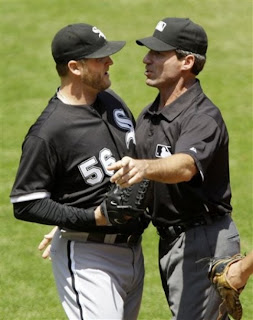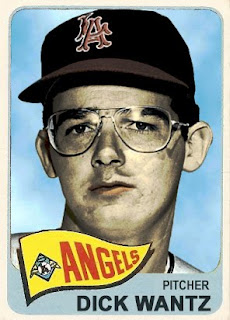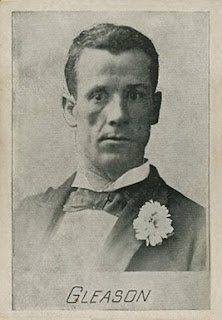
I've waxed poetic about how my dad bought a pack of 1983 Topps for me. I've recounted the story of the Alfredo Griffin card found in that first pack and how that hooked me into collecting. I've told the story many times of how the White Sox kept luring me back into the hobby, time after time.
That's all fine and dandy, but I began to really wonder what held my fascination as a fickle kid. What kept me collecting? When fads come and go and rarely push the two week mark, what has kept my big toe in the waters of baseball card collecting?
I couldn't immediately think of an answer, other than I was a complete obsessive nut as a kid... but that didn't describe my childhood at all. Sure, I stuck with things longer than most kids would, but if there wasn't something I liked about it, I wasn't going to waste my time and energy with it. I had better things to do with my free time.
This really started to get under my skin, so I retraced my steps. I tried to think of anything I possibly could to give me a clue into where my head was at that time. My memory is usually good when diving into the past, but for whatever reason, this fact that I was seeking was escaping me.
Then a chance sentence uttered by my aunt gave me my first good clue.
"I can still remember that Wade Boggs hit .361 in 1983."
Huh? I don't even remember that off the top of my head and my aunt does not follow baseball.
After a little probing, I found out that when my aunt lived with my family for a short while, I would rattle off the statistics on the back of baseball cards and quiz her. I can recall many things that my aunt and I did together at that time, including my recreation of the Thriller video on my front porch, but I have absolutely no memory of this.
I can remember laying out my baseball cards on the floor and stacking them in team order or year order or alphabetical order, depending on my mood. I would lay them out and go through them. I would marvel at each team. Test my memory on past teams. I'd try to figure out a player's past by tracing his minor league teams. I was pretty good at remembering that stuff until I discovered that teams switched affiliations often. I even tried to figure out the complexities of having a team in Hawaii play teams in the other 49 states.
I could recall all of that, but I still could not conjure up the memory of quizzing my aunt. I can come up with fuzzy memories, but nothing definitive. But that clue led me to the realization of why I stuck with it.
In those sets, the common player was as important as the star player. I could pick a card at random and find something interesting about that person, whether he was the MVP or the guy who worked at the local hardware store during the offseason. There was a story behind every player. There was a story during the season and a story away from the game. These were people, not product.
I looked at the majority of the players and their respective cards, from the eighties, and I can envision myself in that role. Me. The kid who loved sports, but wasn't the best athlete. If someone that looked like my next door neighbor could do this, so could I. If someone liked this television show or had an interest in this subject, they might be just like me.
Today, it's rare to see a card of everyone on the team. Players look like they live at the gym rather than in your neighborhood. There's a level of disconnect that I would imagine most kids can't identify with. They can't see themselves in there, unless they are the star of their school baseball team. Even that is no guarantee.
When I look at my origins as a collector, I find that I could identify with those players more than the players of today. There are some players today that are approachable and that people can identify with, but that is a rare commodity.
I can understand wanting to fill a set with nothing but the most popular players and rookies. It makes sense from a marketing standpoint. It takes more than 100 players to fill out the rosters of 30 different teams. Of course you'd want about three cards of each superstar, so that leaves around 80 different players in a typical set of current players. Let's not forget that the popular teams get more cards. You're left with one or two cards for each average team. That's not the way to get kids to know a roster full of players.
The argument will now be for the flagship set. With Upper Deck and their 1,000 card set out of the picture (which still had three or more cards of some players), you are left with 600 cards out of a set of 660 for actual players. Add on an update set which will tack on All-Stars, highlights, more rookies and players that changed teams and you are left with maybe 50 cards of players that were left out of the first two series. Out of 750 initial players, around 100 are left without a card.
Is this a new thing? Nope. It is getting more prevalent as the years pass. If one good thing can come out of a single license, hopefully it will be a return to basics. I don't need three cards of every player in one set. I need every player that played during the season to be represented in some way on cardboard. Hopefully, any multiple cards of players would reflect each team change during the year. If one set can claim to do all that, I would be very happy.
I learned about every player when I first collected. I learned the history of the game back then too. I also learned about the cool quirky things that can happen during a baseball game back then. I learned most of that information through cards. A lot of what I learn about modern day players, I have to learn from other sources. Maybe that is why cards aren't as relevant with kids today. It might not be about the latest technology or more shiny foil or whatever the card companies throw out there to entice kids. It might just be about cool statistics, weird facts, anomalies of the game and every player being represented as an equal.
 "'The whim of a madman' I like that!"
"'The whim of a madman' I like that!"  "In dreams... I walk with you. In dreams... I talk to you. In dreams, you're mine... all the time. Forever."
"In dreams... I walk with you. In dreams... I talk to you. In dreams, you're mine... all the time. Forever."






































